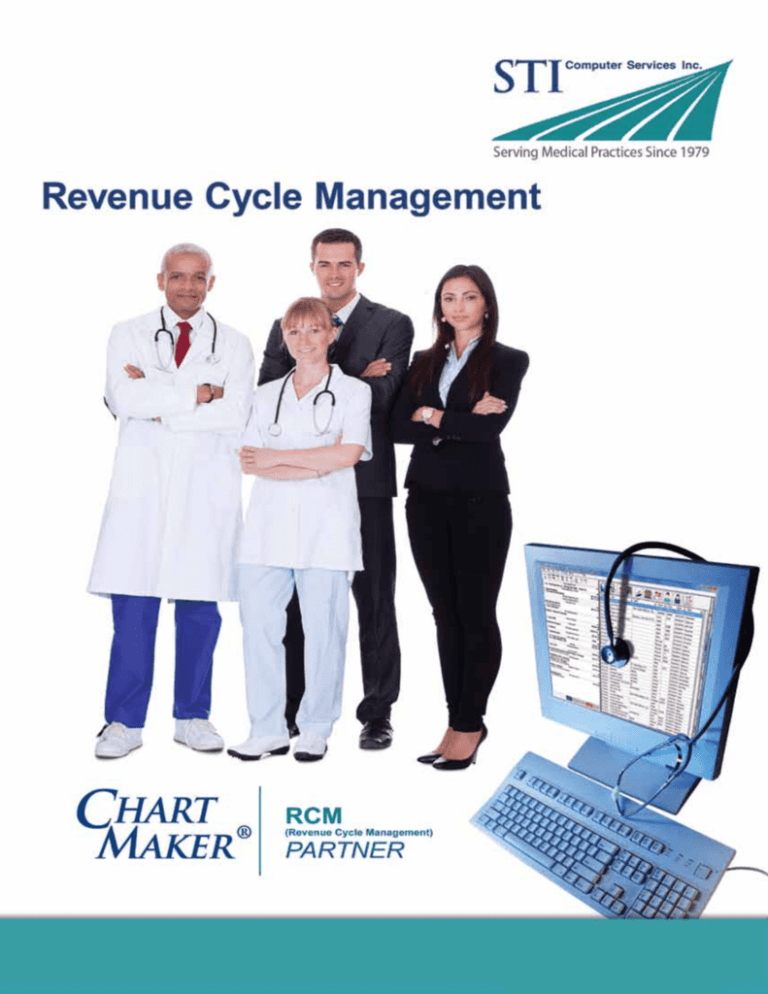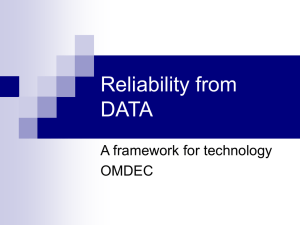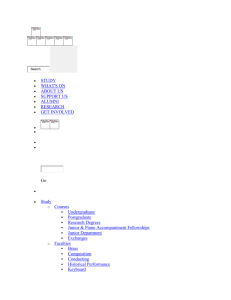
Revenue Cycle Management
Have you heard about Revenue Cycle Management (RCM)?
It is the process of managing the healthcare revenue cycle
within your office that typically results in increased revenue collected, more compensation for physician owners,
reduced practice costs especially for computer technology,
integration of Electronic Health Record (EHR) technology and more time for patient care. I know that it probably
sounds too good to be true in today’s complicated medical environment, but it is happening in medical practices
throughout the country.
Optimized
The key to the success of this approach is the sharing of
ChartMaker’s advanced software technology by both parties
in a cooperative manner and the division of specialized and
knowledgeable labor. This way, the practice can concentrate
on issues that they do best such as appointment scheduling,
patient registration, utilizing electronic health records with
charge capture and most importantly, patient care issues.
An STI RCM Partner, with specific medical billing and collecting knowledge picks up your claims from that point forward to handle insurance processing with follow-up, patient
billing, and payment posting to maximize your revenue.
You have complete access to the system and all information
remains under your control and ownership. More importantly, your billing and EHR information belongs to you
and can be used by you in a machine readable format if you
continue to use a ChartMaker System after the contractual
period.
Most likely you will substantially reduce your clerical costs
as well as improve your income with professional Revenue
Cycle Management services from an STI Partner.
The Healthcare Revenue Cycle
The Healthcare Revenue Cycle is more than just billing and
collecting your fees. It includes the entire patient process
from patient registration pre-encounter, to the patient/
physician encounter, to your back office processes of billing,
collecting your fees, posting payments, patient reconciliation, insurance appeals and follow-up.
Many medical practices would prefer to concentrate on the
clinical side of the medical practice (patient registration
and the patient/physician encounter) and be less involved
in the back office processes of billing, collecting, calling
insurance companies for proper payment, and posting fees.
ChartMaker’s advanced software technology combined with
our Revenue Cycle Management Partners (RCM) can help
medical practices manage their healthcare revenue cycle
with a concept that we call Revenue Cycle Optimization.
ChartMaker® Revenue Cycle Optimization
Revenue Cycle Optimization (RCO) is the shared use of
ChartMaker software technology at the medical practice
and the RCM Partner, and both parties working cooperatively to collect the maximum, legal reimbursement from
payers and patients in the shortest possible time.
Based upon your revenue volume some or all software and
training charges are waived for the period in which you use
an STI RCM Partner’s services.
Most practices that switch to RCM find that
the benefits include:
• Increased average % of claims paid after 1st submission
• Increased average % of current claims (0-60 Days)
• Reduced denial rate
• Improved net revenue to the practice
• Higher percentage of clean claims
• Reduced outstanding accounts receivables
• Faster claims payment
• Less lost claims
• Improved quality of care by having more time for
patient care issues
• Correct patient information available and
less stress to your staff
Revenue Cycle Management is not about a reduction of staff, it’s about a better use
of your medical staff, the quality of work, and not having to hire more people.
The demands of running a modern medical practice require
more office staff time than was the case even 5 years ago. The
fact of the matter is that there is just more work to do. It’s not
just about managing insurance claims, referrals and authorizations, but new programs like Electronic Medical Records,
ePrescribing requirements, HIPAA, and PQRS requires your
staff to collect and manage more patient information to avoid
financial penalties and qualify for financial incentives.
New medical insurance plan options and the Affordable Care
Act mean that your staff needs to keep up with multiple insurance changes, rules and regulations of multiple and different insurance plans and to check patient eligibility every time
you have an encounter. If your practice plans to become a
Patient Centered Medical Home (PCMH) or an Accountable
Care Organization (ACO) there are more work requirements
to manage and information to collect.
A recent Medical Economics article (3) states that “As doctors
have to meet more and more requirements to get paid, they
need to rely heavily on their staff to collect and enter data
that insurers will review and use to determine payments”. As
one of our customers who switched to an STI Revenue Cycle
Optimization program said to us, “We just couldn’t keep up!”
Revenue Cycle Management is not about the elimination of
labor, rather it’s about how to use your people more productively on items that matter, and more importantly not needing
to add additional staff to keep up with the workload.
Also, there is a concept about the quality of work. For example, sitting on hold for 30 minutes on an insurance payer
phone line is low quality work and not very satisfying to the
person doing the job. Helping a patient solve a problem, or
helping the practice to qualify for financial incentives is high
quality work that is less stressful and more satisfying to your
staff members.
The goal of the STI Revenue Cycle Optimization program is
the division of labor between your staff and an RCM Partner
through the use of shared advanced ChartMaker software.
Your staff is still involved in registering patients, checking
eligibility, making appointments and entering charges. However, your staff will have more time to work on much more
important patient and practice related items when the RCM
Partner is acting as your back office doing the billing, collecting, and following up with insurance companies and patients
to get you paid, quickly and accurately. Everything is available in the ChartMaker System for everyone to review and to
share information, so your practice is always in control. More
importantly, your patient information can reside in a secure
server at your office location if you wish, or in the “cloud”. It’s
up to you.
Many practices that switch to an STI Revenue Cycle Optimization program find that not only is their medical staff more
satisfied doing higher quality work, but their practice revenue
increases because insurance and patient claims are consistently monitored in a timely approach by a professional and
experienced RCM Partner.
(3) EHRs and audits mean new roles for doctors, staff by Lori E. Rousche,
M.D. Medical Economics magazine September 10th, 2013
What YOU Do
“The Center for Medicare Services (CMS) has repor
While that number is astonishing, more astonishin
are never resubmitted. Using Medicare’s statistics
On a per physician basis, this ranges from app
The Healthcare Revenue Cycle is more than just billing
and collecting your fees. It includes the entire patient
process from patient registration pre-encounter, to the
patient/physician encounter, to your back office processes of billing, collecting your fees, posting payments,
patient reconciliation and follow-up.
Revenue Cyc
Your office needs a knowledgeable and dedicated administrative and clinical staff to efficiently administer
this process. The Healthcare Revenue Cycle is becoming more complex and time consuming with additional healthcare regulations and processes, especially
in smaller medical practices. Many medical practices
would prefer to concentrate on the clinical side of
the medical practice (patient pre-registration and the
patient/physician encounter) and to be less involved
in the back office processes of billing, collecting and
posting fees. Efficiency, knowledge, advanced software
technology and organization are the keys to successful
Revenue Cycle Management.
Appointment Scheduling
STI and our RCM Partners feel that we can help many
medical practices in managing the healthcare revenue
cycle with a concept that we call Revenue Cycle Optimization. Revenue Cycle Optimization is the shared use
of advanced software technology between the medical
practice and the RCM Partner working cooperatively
to collect the maximum, legal reimbursement from
payers and patients in the shortest possible time. You
have complete access to the system, and all information
remains under your control and ownership. Most likely
you will substantially reduce your clerical costs as well
as improve collections with professional Revenue Cycle
Management services from an STI Partner.
Patient Registration & Eligibility Checking
Healthca
C
The key to the success of this approach is the sharing
of ChartMaker’s advanced software technology by both
parties in a cooperative manner and the division of specialized labor so that the practice concentrates on issues
that they do best and an STI RCM Partner, using their
billing knowledge, manages claims to send bills and
follow-up with insurance carriers and patients to collect
and post payments to maximize your revenue.
Electronic EHR with Charge Capture
This is a cooperative Revenue Cycle Management approach in which you enter patient appointments, enter
demographic information, check patient insurance eligibility, and capture charges into the electronic charge
slip within the EHR.
STI Computer Services, Inc.
4
ChartMaker® Medical Suite
What WE Do
rted that it rejects 26% of the claims it receives.
ng is the fact that 40% of those rejected claims
s, the lost revenue per physician is about 10%.
proximately $25,000 to over $50,000” (1).
First, your charges are scrubbed for errors, and
electronically transmitted. They are not keypunched nor manually reviewed at the insurance
carrier and, therefore, less likely to be rejected.
Studies show that practices that bill electronically
experience 21% fewer rejections. (2)
cle Optimization
Second, within 24-48 hours we are electronically notified that the submitted claims have been
accepted or rejected. If rejected we correct and
resubmit the claims.
Payment Posting
Third, electronically submitted claims are typically paid faster. “By law, Medicare must pay an
electronic claim in 14 days. The same paper claim
wouldn’t be paid until day 26.” (2)
Fourth, we follow up on your insurance claims.
They are automatically tracked, and if a claim is
not paid, we contact the carrier and review the
charge, and if necessary, resubmit the claim.
Fifth, after you are paid we can check your contracted fees to ensure that you are being paid
correctly and automatically bill your secondary
carrier or patient.
Electronic Claims Submission
Sixth, we either manually or electronically post
your EOMBs, submit to secondary carriers, and
balance bill your patients, saving most practices
thousands of labor hours each year.
(1). HCFA Continues to “Re-Engineer” Medicare. BDO Seidman,
LLP, Healthcare Advisory Services newsletter. March 2000.
(2). Speed up payments with electronic transmissions, by
Kristie Perry Dolan, Medical Economics Magazine, October 27,
1997, pgs 59-60.
are Revenue
Cycle
-----
Claim Scrubbing
RCM
(Revenue Cycle Management)
PARTNER
800 487-9135
5
www.sticomputer.com
Managing The Healthcare Revenue Cycle
To evaluate an RCM Partner you need to determine your
internal cost of collections and compare that to the RCM
cost plus any additional collections that they can provide. For
example, if they can collect an additional $10,000/month you
receive more revenue than before using an RCM Partner, and
your staff is available to do more important work on patient
care. So an RCM Partner can in effect pay for itself.
A successful billing process starts with the right practice
management and electronic billing software like the ChartMaker Medical Suite. Once you’ve chosen your computer
technology, the next step is to decide whether to assign
the billing function to your own office in-house staff or
outsource it to an STl Revenue Cycle Management (RCM)
Partner.
The billing process relies on getting the correct patient and
insurance information into the system. Errors in data entry
result in rejections, and it’s possible that a claim can be
electronically submitted but immediately denied without
ever entering the payer’s system for processing. Often, staff
in the physician’s office forget or don’t have time to retrieve
the next-day reports that will tell you if your claims were accepted. A rejection on this vital report means that your claim
was not in fact submitted. If your staff doesn’t catch the error
in time, the claim may be rejected for timely filing with no
appeal possible.
An STl RCM Partner can insure that charges entered by you
or your office staff are done correctly and completely. They
will submit your claims, retrieve the next-day reports, and resubmit any necessary corrections. They will record payments
and follow up on denials, rejections, and low payments.
Skilled staff at an RCM Partner can review your aging reports
for slow pays, uncover unpaid claims that have been purged
by the insurance companies, and send bills to secondary payers. Patient bills can be submitted for you, and if you choose,
your patients can call the RCM Partner with questions
instead of interrupting your busy staff.
The advantage of using an RCM Partner is that you reduce
internal labor costs and a professional partner most likely
will have more experience dealing with the insurance carriers
than your own staff since this is all that they do. That frees
your staff to provide better patient service and not sit on the
phone talking to insurance carriers.
Since an RCM company only gets paid a percentage of your
collections, they need to work your accounts to get paid. For
example, the RCM Partner receives only pennies of each
dollar collected for you.
6
STI Revenue Cycle Management partners have been trained
to work with the ChartMaker software. These companies can
provide you the option of either a cloud based or client-server
version of ChartMaker. With a cloud based model, your data
resides at the RCM location and they are responsible for software, back-up and server costs. With a client-server version
the ChartMaker software is installed in your location and you
control the billing information and the RCM Partner comes
into your system on a secure computer line.
The combination of the ChartMaker EMR system with a
professional RCM service to verify the accuracy of billing
information and to follow-up on claims can provide any practice an advantage. With the ChartMaker EMR a physician can
enter charge and diagnostic information directly from the
patient chart. That information can be accessed and processed
by an RCM Partner for processing and follow-up, freeing
your staff of time consuming telephone calls and providing
you with more compensation.
The Right Choice for Revenue Cycle Management
We would like to show you how our Advanced
ChartMaker Software Technology, Superior Billing
Knowledge and Consolidated Labor can collect more of
your fees.
ChartMaker software, in the hands of a trained STI RCM
Partner, can save you time and improve your cash flow.
A professional RCM Partner becomes your back office,
providing knowledgeable employees who are focused on
getting you paid. You may realize lower costs, reduced errors, and increased revenues when you use one of our RCM
Partners.
Billing Knowledge
STI RCM Partners have years of experience working with
physician offices such as yours. Our staff keeps in touch
with the insurance carriers to stay up-to-date on the latest
billing requirements, and to keep you informed of the latest
government regulations. An RCM Partner can help eliminate lost revenue in your practice. “We can save your practice money because our billing knowledge and consolidated
labor force act as your billing and collection department.”
if the insurance carrier received your claim, or its status,
without a telephone call for follow-up. Many insurance
companies purge claims that have not had an inquiry. If
your staff complains about the amount of time spent on the
telephone following up with insurance carriers or resubmitting claims, we can help.
It is no wonder that many busy practices give up trying to
collect a portion of their charges with the continuing cycle
of submitting claims, waiting, telephone follow-up, requests
for resubmittal of claims, waiting again, resubmitting again,
another telephone follow-up, and so on. An RCM Partner
eliminates this labor cost to your practice and collects more
of your money.
The Cost
Between the increased revenue collected by an STI RCM
Partner and more time for patient care, most practices that
switch to Revenue Cycle Optimization find that they have a
net saving even after paying the fixed percentage fee for the service.
Consolidated Labor
Most practices incur additional labor costs in tracking
insurance claims. In some cases, there is no way to know
ChartMaker Clinical 3.7
2011
®
Ambulatory EHR
+ Cardiovascular Medicine
+ Child Health
ChartMaker® Medical Suite v 3.7 by STI Computer Services, Inc is 2011/2012 compliant and has been certified by the Certification Commission for Health Information Technology (CCHIT®), an
ONC-ATCB, in accordance with the applicable certification criteria for Eligible Providers adopted by the Secretary of Health and Human Services. This certification does not represent an endorsement by the U.S. Department of Health and Human Services or guarantee the receipt of incentive payments. January 5, 2011 - CC-1112-865040-1 Quality Measures Certified: NQF 0421, NQF
0013, NQF 0028, NQF 0041, NQF 0024, NQF 0038, NQF 0031, NQF 0043 and NQF 0068. • Self Attested Additional Software Used in Testing: cid:image001.png@01CBACA7.1EDE1D60.
Name: ______________________________________________________
Practice: ____________________________________________________
Specialty: ___________________________________________________
Address: ____________________________________________________
STI Computer Services, Inc.
Valley Forge Corporate Center
2700 Van Buren Avenue
Eagleville, PA 19403
____________________________________________________________
City: _______________________________________________________
State: ___________ Zip code: ______________
Telephone: __________________________________________________
Email:_______________________________________________________
o Please call me for a demonstration or an exact quote.
o Please send information about ChartMaker Medical Suite.
For more information contact:
Joe Cerra at
800-487-9135 extn 1188
or cell phone 610-608-0173,
or by email jcerra@sticomputer.com,
or fax this form to (800) 971-7735.
© Copyright 2013 - EVC - All Rights Reserved.
Technology and Teamwork ...so you can focus on practicing medicine.
Copyright 2013 EVC, All Rights Reserved.7- 22013
STD PRESORT
US Postage Paid
Permit 118
Pleasantville, NJ
08232
STI COMPUTER SERVICES, INC.
VALLEY FORGE CORPORATE CENTER
2700 VAN BUREN AVENUE,
EAGLEVILLE, PA 19403
Revenue Cycle Management can Benefit your Medical Practice.
Revenue Cycle Management (RCM) is a process to manage
and track practice claims and payments. It requires using
sophisticated software technology and specialized billing knowledge to keep track of the claims process and to
increase the amount of revenue collected.
The claim tracking process provided by ChartMaker’s
advanced software technology ensures claims are not lost
and payments are collected. The billing knowledge of an STI
RCM Partner addresses the processing of insurance claims,
follow-up on denied claims, which can cause the majority of
lost revenue to a practice, and posting, freeing your staff to
concentrate on more important patient issues.
Successful Revenue Cycle Management requires technology, billing knowledge, and time to complete the revenue
cycle process. Many medical practices cannot keep up with
this process due to the difficulty in managing the day-to-day
operation of a busy medical practice. Patient issues cause interruptions to your staff that require more of their attention
and time. So time that is needed for calling and following up
with payers is not available and revenue is typically lost unless you add more staff. An STI RCM Partner’s only job is to
work on your claims and collect your revenue. In addition to
specialized billing knowledge, they are not interrupted with
patient issues. An STI RCM Partner concentrates on collecting your revenue.








